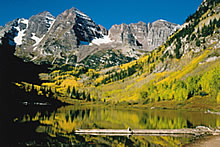How to Survive a High Altitude Vacation
by Gerry Watkins
Mountain
vacations can be hazardous to your health if you aren't prepared for problems
associated with altitude changes. At least 40 percent of mountain visitors suffer
some ill effects from the change. Some experience nothing more than mild shortness
of breath. Others develop flu-like symptoms connected to acute mountain sickness.
My husband and I once became victims of this illness.
 |
| Pictured
above are The Maroon Bells, a range of snowcapped peaks near Aspen, Colo. Photo
courtesy of Denver CAB. |
The
travel brochure had portrayed a peaceful setting: a blue lake rimmed with fir
trees accented by a backdrop of rugged, snowcapped peaks; campers seated at an
inviting picnic spread; a fisherman displayed a beautiful rainbow trout ready
for the frying pan. These images filled our minds as our plane landed in Denver.
We could
hardly wait to catch that first trout.
We'd
driven to Colorado for previous vacations, but this time we opted for air travel,
spending those extra days in a cabin high in the Rocky Mountains. But one thing
we hadn't counted on; it takes time to adjust to higher elevations, and the days
we spent driving there in the past had given us time to become acclimated.
After
getting on the road in our rental car I noticed the discomfort I'd felt upon arrival
getting worse. My mouth and skin felt dry, my head ached, and I felt nauseous.
The fishing fantasy faded into the background; I began to fear that we'd picked
up flu germs somewhere along the way.
By
nightfall, neither of us felt very hungry, so we ate a light meal and turned in
for the night, hoping to sleep it off. But sleep wouldn't come, in spite of the
allergy and sinus medications we took every four hours.
Three
miserable days later we found our way to a local medical clinic. The doctor there
diagnosed high altitude sickness, administered oxygen therapy and gave us a supply
of Diamox. We discovered we'd been wrong to take the allergy and sinus medication,
and should have been taking fluids from the time we left the plane.
"Take
it easy for the next few days, and then ease into your activities," advised
the doctor. "Leave off aspirin, sleeping and sinus medications."
RTM's
travel editor Rachel L. Miller was one of the 20%-30% of Colorado visitors who
fall prey to altitude sickness. She felt the first symptoms within 24 hours and
described the sickness as "very flu-like, but with lightheadedness and occasional
disorientation." She finally felt partially recovered on her third (and last)
day in Colorado. "It probably wasn't so smart that I was doing so much physical
activity during my trip -- I know now that probably didn't help my case much."
Doctors advise rest if you come down with altitude sickness.
The
incidence and severity of altitude sickness are related to altitude, speed of
ascent, physical exertion and prior acclimatization. Some people are particularly
susceptible to it and experience similar episodes with each exposure. Symptoms
of headache, shortness of breath, anorexia or nausea, weakness dyspnea and "flu-like"
malaise may begin 6 to 48 hours after ascent. |
Symptoms
of this illness include headaches, nausea, loss of appetite, and insomnia, or
inability to sleep soundly through the night. In severe cases patients may experience
extreme shortness of breath, a cough, congestion and difficulty with thought processes.
Still
others may develop a rare condition known as high altitude pulmonary edema (HAPE),
similar to pneumonia. Fluid collects in the victim's lungs, causing breathing
difficulty, accompanied by a cough. This illness is serious and, if not treated,
can lead to death. HAPE seems to occur more during the winter months than during
summer, probably because summer visitors come to the mountains to relax rather
than to party.
The
sickness can occur regardless of a person's age or overall health, and it seems
to attack men more frequently than women.
Mountain
illnesses develop within the first few days of arrival and should disappear as
your body adjusts to the altitude. The adjustment could take anywhere from three
days to three weeks. That could ruin a vacation.
Families
with children too young to tell their parents how they feel should watch closely
for the symptoms. If diarrhea or vomiting occurs, maintain body fluids by giving
the child water, milk, or juices. Consult a physician if the condition worsens
or doesn't improve.
Even
a mild cold can cause an earache at higher altitudes. The barometric pressure
changes drastically when you are driving over mountain passes. If you suspect
infection, see a doctor. A pain relief medication containing acetaminophen, such
as Tylenol (never aspirin) may be used until you can obtain treatment.
What
causes mountain illness? Cooler, drier air at high altitudes contains less oxygen
than sea level air. "Breathing faster is the only way the body can adapt
to the altitude," the doctor at Summit Medical center in Frisco, Colorado
told us. "When you breather faster, you lose more body fluids. Lips and skin
feel dry and scratchy."
Some
doctors believe the lack of oxygen causes extra fluid to develop in brain cells,
prompting them to swell and bringing on the sickening symptoms. Other doctors
believe the change in body fluid affects the kidneys and changes the blood chemistry.
 Diamox,
a drug prescribed for altitude sickness (or acute mountain sickness), controls
fluid secretion. It is also used in the treatment of glaucoma (excessive pressure
in the eyes), epilepsy (for both brief and unlocalized seizures), and fluid retention
due to congestive heart failure or drugs. Common side effects include: change
in taste, diarrhea, increase in amount or frequency of urination, loss of appetite,
nausea, ringing in the ears, tingling or pins and needles in hands or feet, vomiting. Diamox,
a drug prescribed for altitude sickness (or acute mountain sickness), controls
fluid secretion. It is also used in the treatment of glaucoma (excessive pressure
in the eyes), epilepsy (for both brief and unlocalized seizures), and fluid retention
due to congestive heart failure or drugs. Common side effects include: change
in taste, diarrhea, increase in amount or frequency of urination, loss of appetite,
nausea, ringing in the ears, tingling or pins and needles in hands or feet, vomiting.
RTM
does not prescribe or support the use of any medications. Please see your doctor
for treatment or the prescription of medications. |
Physicians
usually treat the illness by giving the patient oxygen therapy and a form of Diamox.
Oxygen therapy creates a better bloodstream balance and makes breathing easier.
In our case, one treatment was sufficient. Others may need several treatments
during their stay. Diamox allows more oxygen to be taken in by the lungs, so the
victim can breathe faster and more deeply. If treatment doesn't bring relief,
the patient should move to a lower elevation.
Treatment
can salvage the remnants of a vacation, but it's best to avoid the illness altogether
if possible and take full advantage of your time in the mountains.
Give
your body time to adjust by spending an extra day or two traveling to your high-altitude
destination. Increase your fluid intake as soon as you start to climb to higher
elevations. Plan to rest and relax the first day or two after you arrive. Take
frequent breaks from your activities, and avoid narcotics and alcohol, at least
for the first few days, because they can escalate mountain illness symptoms.
Begin
your battle against the illness before you leave home. A few minutes of aerobic
exercise, such as walking or swimming each day, will increase your endurance.
Better still, a sustained exercise program will build stamina for improved resistance.
Any
person with a history of heart, circulatory, or lung problems should check with
a doctor before leaving home. Your doctor can help you prepare for a healthful
stay.
Proper
precautions can prevent other health problems associated with high altitudes.
Severe sunburn happens more easily at higher elevations. Use plenty of sunscreen
and wear sunglasses. Protect yourself and your time while enjoying your holiday.
--
Gerry Watkins is a free-lance journalist and webmaster of the award winning site www.sundancerswest.com.
|